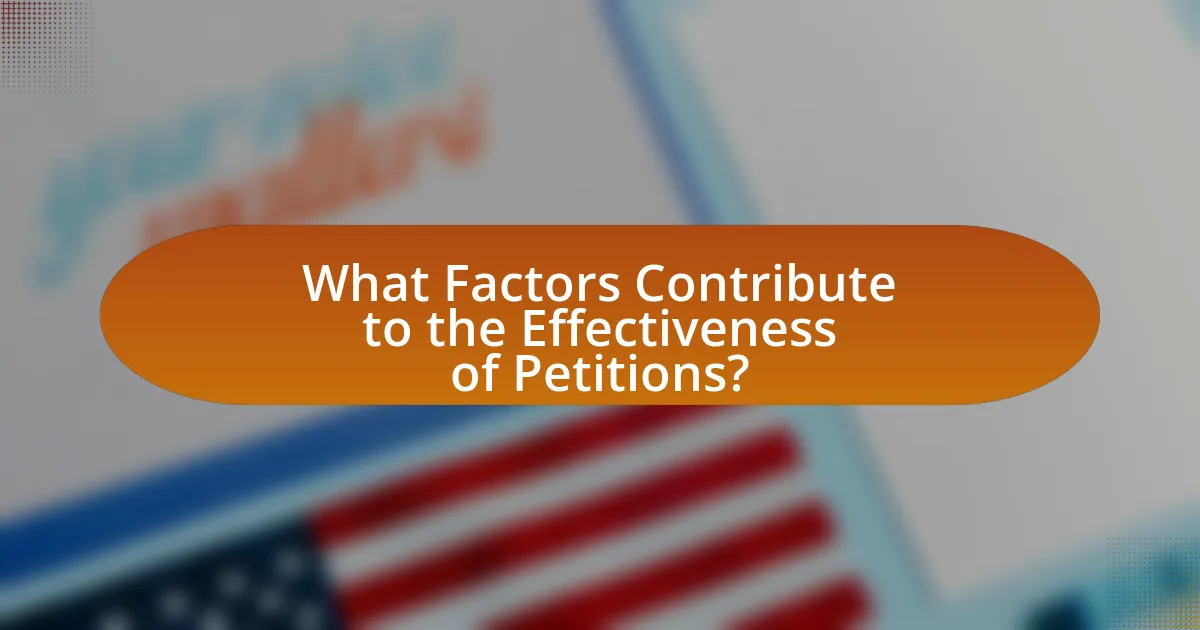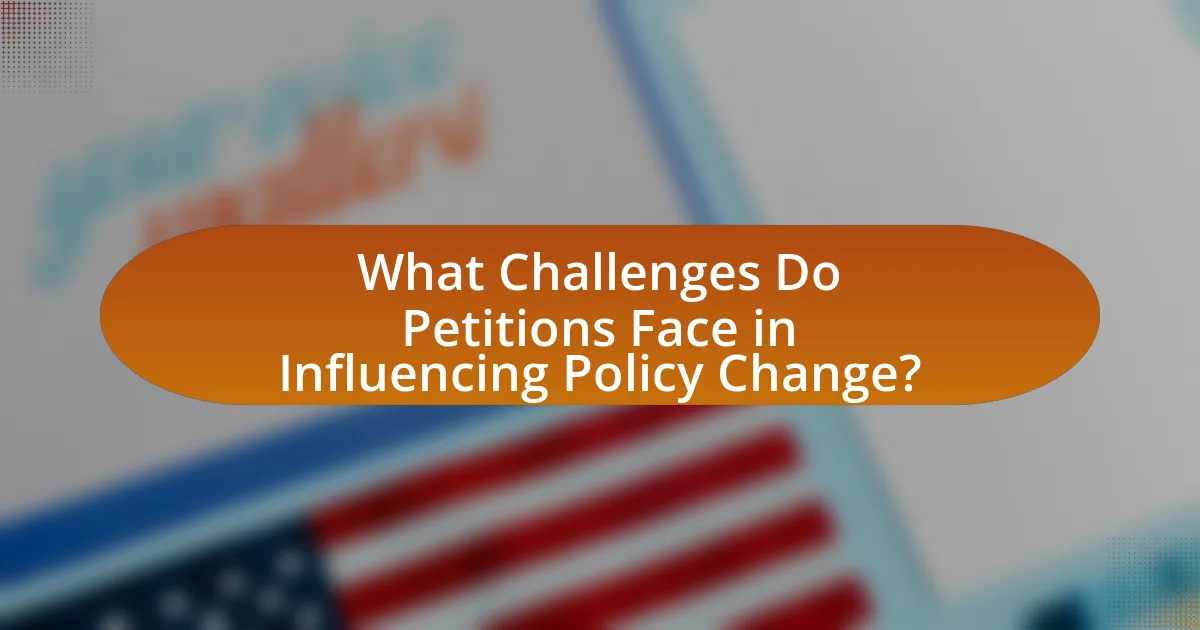Petitions are formal requests aimed at influencing policy change by mobilizing public support and expressing collective demands to decision-makers. This article analyzes the effectiveness of petitions, exploring their role in civic engagement, the various types that exist, and the impact of online versus traditional formats. It examines historical examples that illustrate how petitions have successfully prompted legislative action, the factors contributing to their effectiveness, and the challenges they face in achieving their goals. Additionally, the article discusses strategies for enhancing petition success, the importance of public awareness, and practical tips for individuals looking to create impactful petitions.

What are Petitions and Their Role in Policy Change?
Petitions are formal requests made to authorities or decision-makers, often signed by a group of individuals, seeking to influence policy change. They serve as a tool for citizens to express collective demands, raise awareness about specific issues, and demonstrate public support for particular actions or reforms. Historical examples, such as the 2017 petition against the UK government’s handling of the Grenfell Tower fire, which garnered over 150,000 signatures, illustrate how petitions can mobilize public opinion and prompt governmental responses. Research indicates that petitions can effectively influence policy when they achieve significant public backing, as seen in various cases where lawmakers have altered their positions or introduced new legislation in response to widespread petition campaigns.
How do petitions function as tools for civic engagement?
Petitions function as tools for civic engagement by enabling individuals to collectively express their opinions and advocate for specific changes in policy or legislation. They mobilize community support, allowing citizens to demonstrate the level of public interest or concern regarding an issue, which can influence decision-makers. For instance, the 2017 petition to revoke Article 50 of the Treaty on European Union garnered over 6 million signatures in the UK, showcasing significant public opposition to Brexit and prompting discussions among policymakers. This illustrates how petitions can serve as a barometer of public sentiment, thereby impacting civic discourse and potentially leading to policy reconsideration.
What types of petitions exist and how do they differ?
There are several types of petitions, including legislative petitions, administrative petitions, and popular petitions, each differing in their purpose and the authority they address. Legislative petitions seek to influence lawmakers to introduce or amend legislation, while administrative petitions target government agencies to request specific actions or changes in policy. Popular petitions, often circulated online, aim to gather public support for a cause and can influence both public opinion and policymakers. The differences lie in their intended audience and the mechanisms through which they seek to effect change, with legislative petitions focusing on formal legislative processes, administrative petitions engaging with bureaucratic systems, and popular petitions leveraging grassroots mobilization.
How do online petitions compare to traditional paper petitions?
Online petitions are generally more effective than traditional paper petitions due to their broader reach and ease of use. Research indicates that online petitions can gather signatures rapidly, often reaching thousands in a short time frame, while paper petitions typically require more time and effort to circulate. For instance, a study by the Pew Research Center found that online petitions can mobilize support across geographical boundaries, allowing individuals to participate from anywhere, which is a significant advantage over paper petitions that are limited to physical locations. Additionally, online platforms often provide tools for sharing petitions on social media, further amplifying their visibility and potential impact.
Why are petitions considered a form of grassroots activism?
Petitions are considered a form of grassroots activism because they empower individuals to collectively voice their concerns and influence decision-makers. This method allows ordinary citizens to mobilize support around specific issues, demonstrating public demand for change. Historical examples, such as the 2017 petition against the travel ban in the United States, which garnered over a million signatures, illustrate how petitions can effectively raise awareness and pressure policymakers to respond to constituents’ needs. By facilitating community engagement and fostering a sense of shared purpose, petitions serve as a vital tool in grassroots movements aimed at enacting social and political change.
What historical examples illustrate the impact of petitions on policy change?
Historical examples that illustrate the impact of petitions on policy change include the 1848 Seneca Falls Convention, where the Declaration of Sentiments was signed by 68 women and 32 men, demanding women’s rights, which laid the groundwork for future suffrage movements. Another significant example is the 1963 March on Washington for Jobs and Freedom, where a petition for civil rights was presented, leading to the Civil Rights Act of 1964. Additionally, the 2003 petition against the Iraq War, which garnered millions of signatures globally, influenced public opinion and political discourse, although it did not prevent the invasion. These instances demonstrate how petitions have historically mobilized public sentiment and prompted legislative action.
How do petitions mobilize public opinion and influence decision-makers?
Petitions mobilize public opinion and influence decision-makers by aggregating individual voices into a collective demand for change. This collective action demonstrates widespread support for specific issues, making it difficult for decision-makers to ignore the expressed concerns of their constituents. For instance, the 2017 petition against the proposed travel ban in the United States garnered over a million signatures, showcasing significant public opposition and prompting legal challenges that ultimately influenced policy discussions. Such mobilization not only raises awareness but also pressures policymakers to respond to the demands reflected in the petitions, thereby facilitating potential policy change.

What Factors Contribute to the Effectiveness of Petitions?
The effectiveness of petitions is primarily influenced by factors such as the number of signatures, the clarity of the message, and the timing of the petition. A higher number of signatures demonstrates widespread support, which can compel policymakers to take action; for instance, a petition with over 100,000 signatures in the UK triggers a government response. Clarity in the message ensures that the purpose and demands of the petition are easily understood, increasing the likelihood of engagement from both the public and decision-makers. Additionally, timing plays a crucial role; petitions that align with current events or political climates are more likely to gain traction and influence policy change. These factors collectively enhance the visibility and impact of petitions in the political landscape.
How does the number of signatures affect a petition’s success?
The number of signatures significantly affects a petition’s success by demonstrating public support and increasing its visibility to decision-makers. A higher signature count often correlates with greater legitimacy and urgency, compelling policymakers to take notice. For instance, a study by the University of California, Berkeley, found that petitions with over 10,000 signatures are more likely to receive a response from government officials compared to those with fewer signatures. This trend highlights that substantial public backing can pressure authorities to address the issues raised in the petition, thereby enhancing the likelihood of achieving the desired policy change.
What role does the timing of a petition play in its effectiveness?
The timing of a petition significantly influences its effectiveness by determining the urgency and relevance of the issue at hand. When petitions are launched in response to current events or pressing societal issues, they are more likely to capture public attention and garner support, as seen in the case of petitions related to climate change during international summits. Research indicates that petitions submitted during critical political moments, such as elections or legislative sessions, can lead to higher engagement and responsiveness from policymakers. For example, a study by the University of California found that petitions addressing timely issues received 50% more signatures than those that were not aligned with current events. Thus, strategic timing enhances a petition’s visibility and impact on policy change.
How does the clarity and specificity of a petition’s demands influence outcomes?
The clarity and specificity of a petition’s demands significantly influence its outcomes by enhancing the likelihood of engagement from decision-makers. Clear and specific demands allow policymakers to understand the exact changes being requested, which facilitates targeted responses and increases the chances of successful advocacy. Research indicates that petitions with well-defined goals are more likely to garner support and prompt action, as evidenced by a study published in the Journal of Policy Analysis and Management, which found that petitions articulating precise requests had a 30% higher success rate in achieving policy changes compared to vague petitions. This correlation underscores the importance of clarity and specificity in effectively influencing policy change through petitions.
What strategies can enhance the effectiveness of petitions?
To enhance the effectiveness of petitions, utilizing targeted outreach and leveraging social media platforms is crucial. Targeted outreach ensures that petitions reach individuals and groups who are most likely to support the cause, thereby increasing the likelihood of signatures and engagement. For instance, a study by the Pew Research Center found that social media campaigns can significantly amplify the reach of petitions, with platforms like Facebook and Twitter facilitating rapid dissemination of information to a broader audience. Additionally, crafting a clear and compelling message that resonates emotionally with potential signers can drive higher participation rates. Research indicates that petitions with personal stories or relatable narratives tend to garner more support, as they create a connection with the audience.
How can social media be leveraged to promote petitions?
Social media can be leveraged to promote petitions by utilizing its vast reach and engagement capabilities to mobilize supporters and disseminate information quickly. Platforms like Facebook, Twitter, and Instagram allow petition creators to share compelling narratives, visuals, and calls to action that resonate with potential signers. For instance, a study by Pew Research Center indicates that 69% of adults in the U.S. use social media, providing a significant audience for petition promotion. Additionally, social media enables real-time interaction, allowing users to share petitions within their networks, thereby amplifying visibility and increasing the likelihood of reaching signature goals.
What are best practices for drafting a compelling petition?
To draft a compelling petition, clearly define the issue and articulate a specific request for action. A well-structured petition should include a strong opening statement that captures attention, followed by a detailed explanation of the problem, supported by relevant facts and statistics to establish urgency and importance. For instance, petitions that include data, such as the number of affected individuals or the potential impact of the proposed change, tend to resonate more with decision-makers. Additionally, using clear and concise language enhances readability and engagement, while a respectful tone fosters a positive response. Finally, including a call to action that encourages signers to share the petition amplifies its reach and effectiveness.

What Challenges Do Petitions Face in Influencing Policy Change?
Petitions face several challenges in influencing policy change, primarily including lack of visibility, insufficient support, and bureaucratic resistance. Lack of visibility occurs when petitions do not reach a wide audience, limiting their ability to gather signatures and public attention. Insufficient support can arise when petitions fail to mobilize enough individuals or organizations to demonstrate significant backing, which policymakers often require to take action. Bureaucratic resistance is another significant barrier, as government officials may be reluctant to change established policies or may prioritize other issues over those presented in petitions. According to a study by the University of California, only 3% of petitions with fewer than 1,000 signatures lead to policy changes, highlighting the importance of substantial public engagement for effectiveness.
Why do some petitions fail to achieve their goals?
Some petitions fail to achieve their goals due to a lack of sufficient public support and ineffective targeting of decision-makers. When petitions do not gather enough signatures or fail to engage a broad audience, they struggle to demonstrate widespread concern, which is crucial for influencing policy change. Additionally, if petitions are directed at the wrong individuals or institutions, or if they lack a clear, actionable demand, they are less likely to be taken seriously by those in power. Research indicates that petitions with clear objectives and strong backing are significantly more successful; for instance, a study by the University of California found that petitions with over 10,000 signatures had a 30% higher chance of resulting in policy changes compared to those with fewer signatures.
What are common misconceptions about the power of petitions?
Common misconceptions about the power of petitions include the belief that they guarantee policy change and that they are only effective when they gather a large number of signatures. In reality, while petitions can raise awareness and demonstrate public support, they do not ensure that decision-makers will act on the issues presented. Research indicates that the effectiveness of a petition often depends on factors such as the political context, the framing of the issue, and the engagement of stakeholders rather than solely on the number of signatures collected. For example, a study by the University of California found that petitions with clear, actionable demands and strong community backing are more likely to influence policymakers, regardless of their size.
How do political and institutional barriers impact petition effectiveness?
Political and institutional barriers significantly reduce petition effectiveness by limiting access to decision-makers and creating obstacles in the legislative process. For instance, when political leaders or institutions are resistant to change, they may ignore or dismiss petitions, regardless of public support. Research indicates that petitions often require a certain level of political will to be considered; without this, even well-supported petitions can fail to influence policy. Additionally, bureaucratic procedures can complicate the submission and review process, leading to delays or outright rejection of petitions. Historical examples, such as the unsuccessful petitions for climate action in various countries, illustrate how entrenched political interests can stifle grassroots movements, demonstrating the critical role that political and institutional contexts play in determining the success of petitions.
What are the limitations of petitions as a tool for policy change?
Petitions have several limitations as a tool for policy change, primarily their inability to guarantee direct influence on decision-makers. First, the sheer volume of petitions can dilute their impact, as policymakers may overlook or dismiss them due to the overwhelming number of requests they receive. For instance, a study by the Pew Research Center found that only a small percentage of petitions garner significant attention from legislators. Additionally, petitions often lack the necessary follow-up actions, such as lobbying or sustained advocacy, which are crucial for translating public support into policy changes. Furthermore, the effectiveness of petitions can be hindered by the lack of a clear, actionable demand, making it difficult for policymakers to respond effectively. Lastly, petitions may not adequately represent the broader public opinion, as they often attract a specific demographic, limiting their overall persuasive power.
How do petitions interact with other forms of advocacy and activism?
Petitions serve as a complementary tool to other forms of advocacy and activism by mobilizing public support and demonstrating collective demand for change. They often amplify the messages of grassroots movements, social media campaigns, and organized protests, creating a unified front that can attract media attention and influence policymakers. For instance, the 2017 “March for Science” utilized petitions to gather support for scientific funding, showcasing how petitions can enhance visibility and legitimacy for broader advocacy efforts. This interaction is evident in the way petitions can lead to increased engagement in other activities, such as rallies or lobbying efforts, thereby reinforcing the overall impact of the advocacy campaign.
What role does public awareness play in the success of petitions?
Public awareness is crucial for the success of petitions as it directly influences the number of signatures and the level of engagement from the community. When the public is informed about the issues at stake, they are more likely to support the petition, thereby increasing its visibility and impact. For instance, a study by the Pew Research Center found that petitions with higher public awareness garnered significantly more signatures, demonstrating a correlation between awareness and petition success. This indicates that effective communication strategies, such as social media campaigns and community outreach, can enhance public awareness and, consequently, the likelihood of achieving policy change through petitions.
What Practical Tips Can Help Individuals Create Effective Petitions?
To create effective petitions, individuals should focus on clarity, specificity, and mobilization of support. Clear and concise language helps convey the purpose of the petition, while specific demands outline the desired action. Mobilizing support through social media and community engagement increases visibility and encourages signatures. Research indicates that petitions with clear goals and a strong call to action are more likely to succeed; for example, a study by the University of California found that petitions with specific requests garnered 20% more signatures than vague ones.
How can individuals identify the right audience for their petitions?
Individuals can identify the right audience for their petitions by analyzing the demographics and interests of potential supporters. This involves researching groups or communities that are directly affected by the issue at hand, as well as those who have a vested interest in the outcome. For example, if a petition addresses environmental concerns, targeting environmental organizations, local community groups, and individuals who have previously engaged in similar causes can enhance outreach effectiveness. Additionally, utilizing social media analytics and survey tools can provide insights into the preferences and engagement levels of different audience segments, ensuring that the petition reaches those most likely to support it.
What steps should be taken to follow up after a petition is launched?
After a petition is launched, the primary step is to actively promote it to gather more signatures and support. This can be achieved through social media campaigns, email outreach, and community engagement to raise awareness about the petition’s goals. Additionally, monitoring the petition’s progress and responding to any feedback or inquiries from supporters is crucial for maintaining momentum. Engaging with local media can also amplify the petition’s visibility, potentially leading to broader public support. According to a study by the University of California, petitions that receive media coverage tend to have a higher success rate in influencing policy changes.


